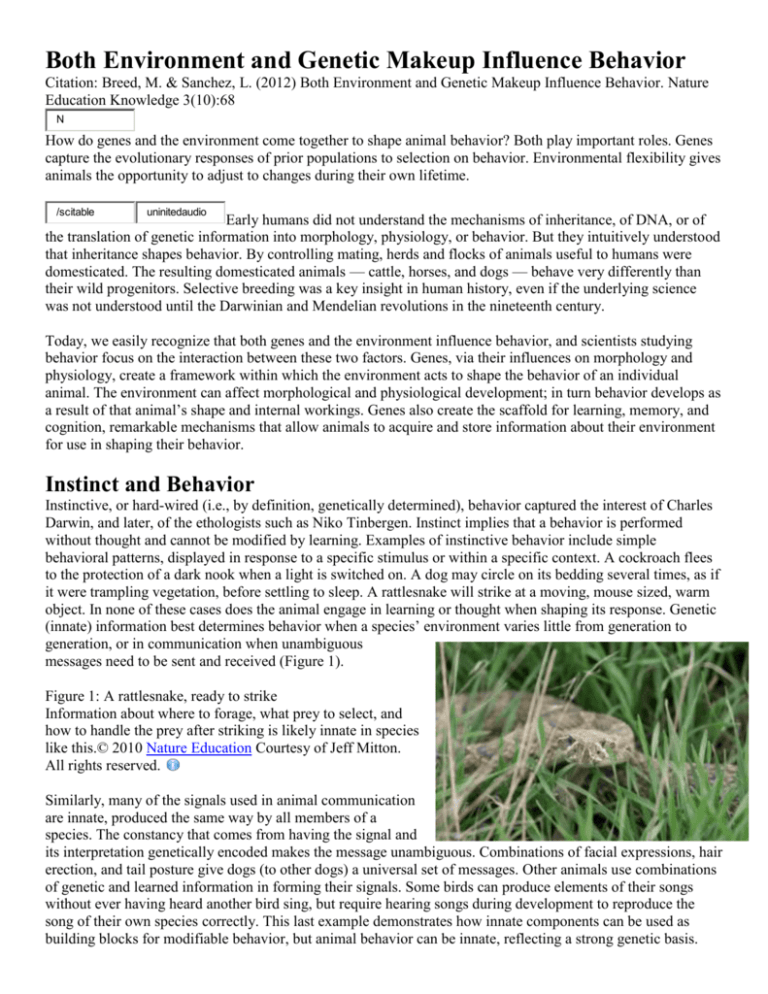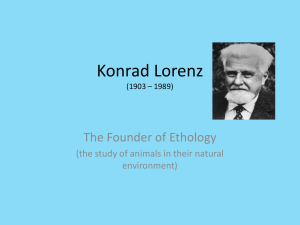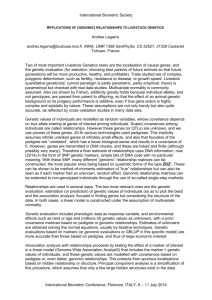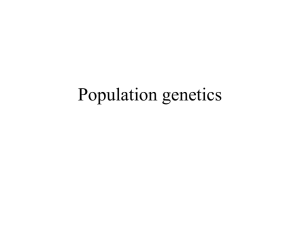
Both Environment and Genetic Makeup Influence Behavior
Citation: Breed, M. & Sanchez, L. (2012) Both Environment and Genetic Makeup Influence Behavior. Nature
Education Knowledge 3(10):68
N
How do genes and the environment come together to shape animal behavior? Both play important roles. Genes
capture the evolutionary responses of prior populations to selection on behavior. Environmental flexibility gives
animals the opportunity to adjust to changes during their own lifetime.
/scitable
uninitedaudio
Early humans did not understand the mechanisms of inheritance, of DNA, or of
the translation of genetic information into morphology, physiology, or behavior. But they intuitively understood
that inheritance shapes behavior. By controlling mating, herds and flocks of animals useful to humans were
domesticated. The resulting domesticated animals — cattle, horses, and dogs — behave very differently than
their wild progenitors. Selective breeding was a key insight in human history, even if the underlying science
was not understood until the Darwinian and Mendelian revolutions in the nineteenth century.
Today, we easily recognize that both genes and the environment influence behavior, and scientists studying
behavior focus on the interaction between these two factors. Genes, via their influences on morphology and
physiology, create a framework within which the environment acts to shape the behavior of an individual
animal. The environment can affect morphological and physiological development; in turn behavior develops as
a result of that animal’s shape and internal workings. Genes also create the scaffold for learning, memory, and
cognition, remarkable mechanisms that allow animals to acquire and store information about their environment
for use in shaping their behavior.
Instinct and Behavior
Instinctive, or hard-wired (i.e., by definition, genetically determined), behavior captured the interest of Charles
Darwin, and later, of the ethologists such as Niko Tinbergen. Instinct implies that a behavior is performed
without thought and cannot be modified by learning. Examples of instinctive behavior include simple
behavioral patterns, displayed in response to a specific stimulus or within a specific context. A cockroach flees
to the protection of a dark nook when a light is switched on. A dog may circle on its bedding several times, as if
it were trampling vegetation, before settling to sleep. A rattlesnake will strike at a moving, mouse sized, warm
object. In none of these cases does the animal engage in learning or thought when shaping its response. Genetic
(innate) information best determines behavior when a species’ environment varies little from generation to
generation, or in communication when unambiguous
messages need to be sent and received (Figure 1).
Figure 1: A rattlesnake, ready to strike
Information about where to forage, what prey to select, and
how to handle the prey after striking is likely innate in species
like this.© 2010 Nature Education Courtesy of Jeff Mitton.
All rights reserved.
Similarly, many of the signals used in animal communication
are innate, produced the same way by all members of a
species. The constancy that comes from having the signal and
its interpretation genetically encoded makes the message unambiguous. Combinations of facial expressions, hair
erection, and tail posture give dogs (to other dogs) a universal set of messages. Other animals use combinations
of genetic and learned information in forming their signals. Some birds can produce elements of their songs
without ever having heard another bird sing, but require hearing songs during development to reproduce the
song of their own species correctly. This last example demonstrates how innate components can be used as
building blocks for modifiable behavior, but animal behavior can be innate, reflecting a strong genetic basis.
Imprinting and Development
Imprinting involves the ability to learn a specific essential piece of information at the right stage of
development. Openness for learning through imprinting is restricted to a short time span, called a critical period.
The most famous example of imprinting comes from Konrad Lorenz and his geese. He found that goslings learn
to recognize their mother (and to tell her from other geese) very early in life. By substituting himself for the
mother goose at the right developmental stage, he could get the goslings to imprint on him, and faithfully follow
him wherever he went. The openness of goslings for learning a leader, even if it does not resemble a goose, is
intriguing. Imprinting demonstrates how genes can largely shape a behavior, but that evolution can create a
window for learning important information about variation in the environment (Figure 2).
Figure 2: A Canada goose family
Imprinting by the goslings on their parents helps
to keep the family together.
© 2010 Nature Education Courtesy of Michael
Breed. All rights reserved.
Imprinting provides an opportunity to learn key
variable components in an environment while
retaining largely innate behavioral patterns. More
flexibility may be shown in the development of
food preferences, as food availability can vary
from habitat to habitat, or from season to season.
Insects may imprint on the chemistry of the leaves they eat as caterpillars; when they become adults they then
choose to lay their eggs on plants with a chemistry that matches the leaves they ate when young. This insures a
suitable diet for the next generation. Young birds and mammals often learn food preferences based on food
shared by adults, on observations of feeding preferences of adults, and on sampling possible food items.
Another form of learning involves aversions, which can develop at any
point in any animal’s life. Birds and mammals develop lifelong aversions
to specific foods that contain poisons that cause sickness (such as
monarch butterflies). In contrast, some preferences and aversions appear
to be innate, or at least to be driven by physiological needs for certain
nutrients, such as salt.
Learning About Specific Environments
Figure 3: An eastern fox squirrel
These squirrels scatter hoard their food, such as acorns, giving them a
food supply they can utilize during the winter.
© 2010 Nature Education Courtesy of Jeff Mitton. All rights reserved.
Many animals learn key information for survival. These abilities are often
very specific to a particular context. A species may be very adept at
learning facts that are relevant to its survival, but not be able to employ
learning across a broad range of situations that did not occur in its
evolutionary history. For example, native birds in Guam were completely
unequipped to learn how to evade predation by brown tree snakes, which were introduced into Guam about
1950.
Another good example of this comes from animals that store (or cache) food. Caching is an adaptation to cope
with food supplies that are abundant during a short season, such as fruits and the nuts from trees. Some animals
cache their food at a central location. Honeybees storing honey exemplify this, and centralized caches can
require strong defense against thieves, a notable ability of honeybees. Alternatively, cached food can be
scattered through the habitat; tree squirrels and gray jays are notable for scatter caching (this is sometimes
called scatter hoarding) (Steele et al. 2008). Scatter caching of food stands out as a particularly challenging
context for learning complex information about locations, and birds and mammals that cache food often display
impressive abilities to recall cache locations (Figure 3).
Another set of examples comes from animals that leave their nests to forage, and must therefore learn enough
about their environment to find their way home. The location of a nest or burrow is highly unlikely to remain
constant across many generations; the ability to return home requires the ability to incorporate much
environmental information. Some animals, such as the desert ant, Cataglyphis cursor, incorporate learning into
navigation by using path integration, which is the ability to remember the distances and directions traveled, to
sum them, and then to calculate their return path (Müller & Wehner 1988). Well-developed learning and
calculation abilities are required to integrate a navigational path. Other animals use landmarks, like the position
of the sun, to learn their outward path, which they then use in reverse to return home. Evolution has provided
the innate tools for incorporating learned environmental information in cache retrieval and homing.
Environment, Genetics and Cognitive Development
Cognition allows animals to separate themselves from the immediacy of their environment and to reflect on the
past in order to solve future problems. Cognition involves the ability to make novel associations. Cognition was
once thought to define humanity, or to separate humans from animals, but scientists now recognize that
cognitive abilities are not confined solely to humans. Learning through cognition may be more removed from
genetic constraints than other forms of learning, but cognitive problem solving ability can vary substantially
among different animals within a species. Variation in ability is inherited, so at its core, there is a genetic
element underlying cognitive abilities. Cognition gives animals a high level of flexibility in their social and
physical environments, but even cognition is ultimately constrained by genetic limits.
One interesting aspect of cognition is that it can allow an animal to distinguish itself as a distinct identity. If an
animal looks at its own image in a mirror and recognizes "self" rather than identifying the image as another
animal, then some investigators interpret this as evidence of cognition. A common test is to modify the visual
appearance of an animal (e.g., dying a patch of hair) and then observe the reaction of the animal to its mirror
image. If it touches the dyed patch this is taken as evidence for the animal having a concept of "self." Apes,
some monkey species, elephants and dolphins, all respond positively in mirror tests, supporting the idea that
cognition is important in behavioral development across a broad range of animals (Plotnik et al. 2006).
Social cognition, the ability of an animal to forecast how its own actions will affect its future relationships
within a social group, exists in chimpanzees (although it is more limited than in humans) and may extend to
other species. In social groups without cognition, behavioral interactions are very much "in the moment," driven
by factors such as dominance and family membership. Social cognition allows animals to be more calculating
and manipulative in their social relationships. Chimpanzees do not appear to be mean to other members of their
social group without justification, but they can, and do, exact revenge against group members that exhibit
selfish behavior (Call 2001, Jensen et al. 2006).
Genes and Environment in Human Behavior: Sociocultural Influences
and Politics
An understandable fear held by many humans is that their behavior is pre-determined by their genes. If this
were the case, a person might be uncontrollably locked into bad parenting, violent behavior, or drug addiction.
Most human cultures hold strong beliefs in self-determination and free will, as well as the ability of humans to
separate right from wrong and to make choices about the appropriateness of their actions. Heated arguments
among biologists, philosophers, religious leaders, and ethicists over the relative roles of genes and behavior in
human behavior have brought no simple resolution. The evils of eugenics influence many to oppose
consideration of any role for genetics in human behavior. Some biologists have been criticized for
underestimating the role of thought and reasoning in human behavior, while others have been accused of
ignoring the power of evolution in shaping genetically adaptive behavior. This debate is far from resolved and
will continue to fuel controversy, even as more is discovered about the genetic and evolutionary bases of
behavior.
Conclusion
Evolution has acted so that genes and environment act to complement each other in yielding behavioral
solutions to the survival challenges faced by animals. Innate, or instinctive, responses allow animals to benefit
from generations of natural selection on behavior. Learning gives animals tools to respond to local conditions
and changing environments. Understanding the relative roles of genes and the environment in determining
human behavior continues to create controversy. Behavior is best seen as the result of evolutionary processes
that sometimes create, through genetic coding, behavioral instructions for animals and at other times create
flexible mechanisms to allow animals to solve problems specific to their environment.







